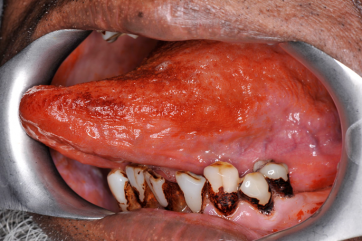Risk factors
The main risk factors in the development of mouth cancer are
- Smoking
- Alcohol
- Human papilloma virus (HPV)
Smoking 
All forms of smoking and chewing tobacco increase the risk of mouth cancer. The effects of smoking are cumulative with heavier smokers and people who smoke for longer periods of time having higher risk. There is a lower risk in ex-smokers and the risk reduces the further they get from quitting. In men 75% of mouth cancers are related to smoking.
Alcohol
Alcohol is an independent risk factor for mouth cancer. As with smoking the effect is dose dependent and the consumption of three or more alcoholic drinks daily doubles the risk. All forms of alcohol (beer, wines and spirits) are implicated. Approximately 20% of mouth cancers are related to alcohol.
Smoking and Alcohol
The effects of smoking and alcohol are more than additive with moderate consumption of both (8-25 drinks weekly and 20-40 cigarette packs per year) putting the person into the high-risk category.
HPV
There is a growing association between HPV and mouth cancer. Studies have identified HPV DNA in 2 out of 3 orpharyngeal cancers (REF Chaturvedi AK2006 and 2011) and HPV is has been described as a leading cause of mouth cancer. The types of mouth cancer associated with HPV infection are distinct from those associated with smoking and alcohol. Patients are mostly younger, have less association with smoking and alcohol and tend to more commonly affect the tonsils and oropharynx.
HPV associated mouth cancer is increasing in prevalence in developed countries. The risk of HPV associated mouth cancer increases with the number of sexual partners and an increases in oral sexual behaviour. It is therefore important for people who are diagnosed with HPV to be made aware of the signs and symptoms of mouth cancer.
HPV associated mouth cancers tend to have a better prognosis than mouth cancers not associated with HPV, particularly with early diagnosis and treatment.
Tobacco chewing and betel quid chewing

Chewing tobacco consumed by placing a portion of the tobacco between the cheek and gum or upper lip teeth and chewing.
Betel quid is a combination of betel leaf, areca nut, and slaked lime. In many countries, tobacco is also added. The combination of tobacco and betel quid is known as gutka, ghutka, or gutkha.
This is most often consumed by placing a pinch of the mixture in the mouth between the gum and cheek and gently sucking and chewing. The excess saliva produced by chewing is sometimes swallowed but some spit this out.
Chewing tobacco and betel quid use are both associated with an increased risk of mouth cancer.
Other risk factors include, diet, genetic factors, immunosuppression and sunlight. Squamous cell carcinomas (SCC) of the lip are approximately three times more likely to metastasise than SCCs arising from other areas of skin (the same is true of SCCs of the external ear).

